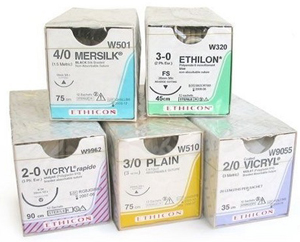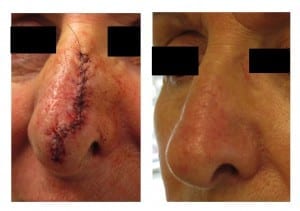Just A Couple Stitches

Mohs micrographic surgery is a unique technique for removing cancerous growths like basal cell carcinoma and squamous cell carcinoma from the skin while sparing the maximum amount of healthy tissue. The skin is typically sutured together to repair the wound or ‘defect’ left by this surgical procedure.
“Patients are often surprised by the number of stitches they see on their skin after their procedure,” says Dr. Adam Mamelak, board-certified dermatologist and fellowship-trained Mohs surgeon in Austin, Texas. While a patient may feel that one or two stitches are all that’s needed, 10 or more may in fact be required to close their skin. And there is good reason for it.
Tip of The Iceberg
“Often, the growth we see on top of the skin does not represent the full extent of the tumor,” explains Dr. Mamelak. Skin cancers can have extensions into and below the skin that are not perceived with the naked eye. Mohs surgery uses a microscope to track these extensions and ensure 100% of the cancer’s roots are removed before a patient goes home.
While most skin cancers are well defined within the skin, at times Dr. Mamelak has been surprised by the full extent of these malignancies. “I have seen tumors three or four times the size of what they appear to be on the skin.” These cancerous cells would surely be missed if the skin cancer was managed with another treatment modality.
 Surgical Algebra: Circles, Ellipses & Vectors
Surgical Algebra: Circles, Ellipses & Vectors
There’s a fair bit of geometry to repairing surgical wounds. “When skin cancers are removed, there are often circular or oval wounds left behind,” says Dr. Mamelak. “When you pull the edges of the circle together, you can leave puckers or pleats on the skin.”
In order to make the skin lay flat, a surgeon will often elongate the circle into an ellipse shape. This will allow the skin to close is a fine flat straight line. Sometimes, your surgeon may choose to perform a skin flap. In this scenario, the surgeon will advance, rotate for transpose skin from an adjacent area to cover the surgical wound.
Hiding In Plain Sight
“One of the keys of surgical reconstruction is to minimize scar and leave a patient with the utmost optimal cosmetic result,” says Dr. Mamelak. “Even though the scar maybe longer, or there may be more stitches anticipated, in the end it will be less noticeable because it lays flat on the skin or is hidden in a natural fold or cosmetic subunit of the face.”
Contact Us
Dr. Mamelak performs skin cancer and reconstructive surgery at Sanova Dermatology and the Austin Mohs Surgery Center. If you have concerns about skin cancer or are looking for the best outcome after your Mohs surgery, please contact us today.
Join Us

